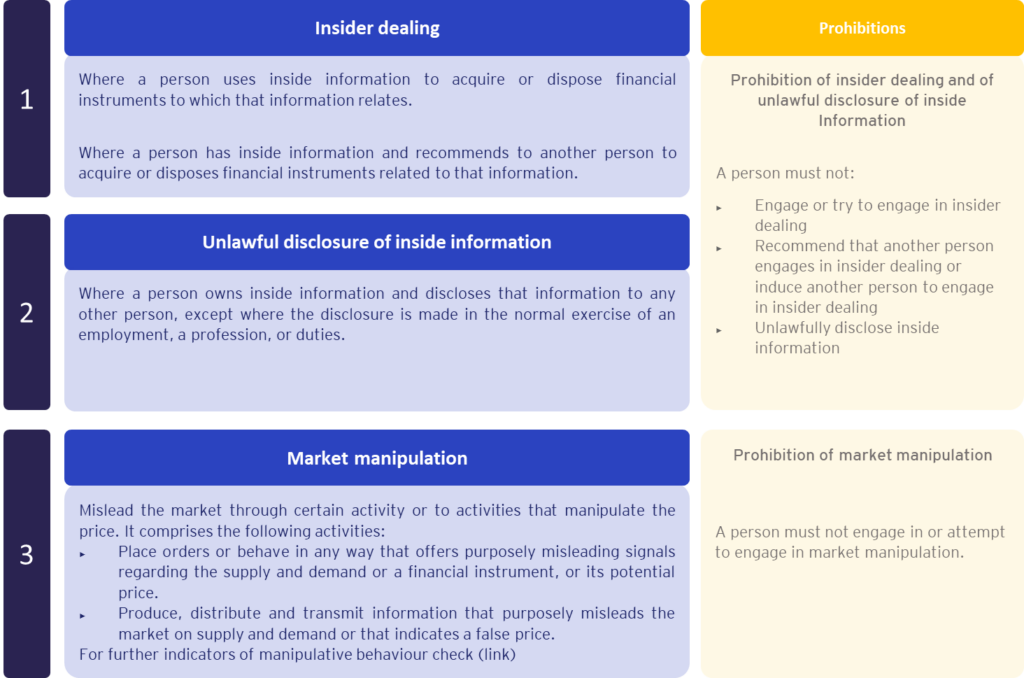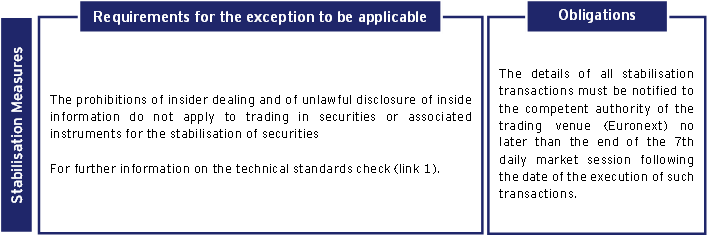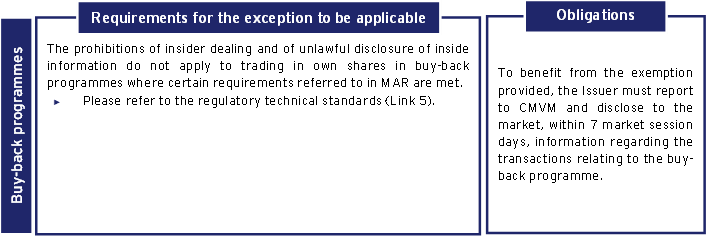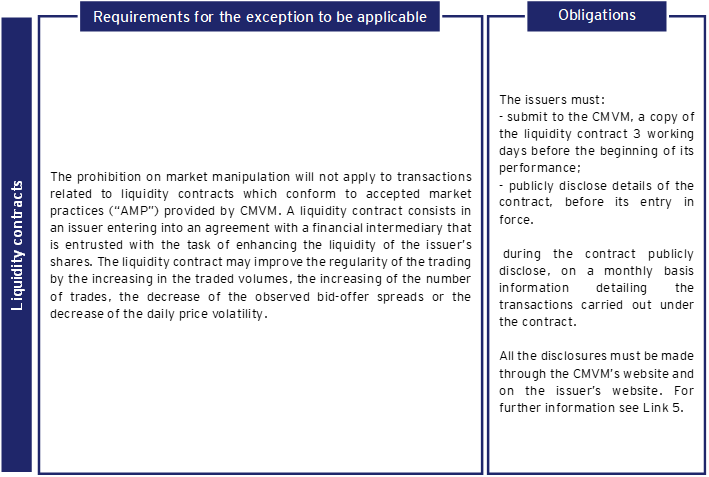Last updated:
The Market Abuse Regulation[1] establishes a regime across the European Union aiming to protect investors by increasing transparency in the financial markets and suppressing market abuse
*Regulation (EU) No 596/2014 of the European Parliament and of the Council of 16 April 2014 on market abuse.
The Market Abuse Regulation creates a unified framework for the EU to address market abuse matters, to ensure an effective and coherent informational workflow across the member states, and seeks to increase market integrity and investor protection, enhancing the attractiveness of securities markets for the raise of capital,
Context
Market efficiency has major importance for the well-functioning and credibility of markets. For a market to be efficient, all the investors should have access to the same information to perform their investment decisions. Additionally, the public disclosure of information increases Issuers’ visibility and credibility. For these reasons, MAR was implemented in the European Union.
According to the MAR, inside information is precise and material information related to the issuer or the financial instruments, which has not been made public. It is expected that the disclosure of inside information impacts the price of the listed shares/bonds, following the reaction of the investors. For example, the disclosure of good financial results will presumably lead to a price increase of the shares.
Please note that:
The following elements are likely to constitute inside information:
Disclosure obligations
EQUITY + DEBT
Public disclosure of inside information
Obligation
What? Inform the public of inside information (meaning material information) which directly concerns that issuer or its securities.
When? Inside information must be disclosed “as soon as possible” meaning that the issuer shall not hold inside information, except if the requirements for delay disclosure are met.
How? CMVM website. Normally, media will further disseminate the information.
Exceptions
In certain cases, the immediate disclosure of certain event may prejudice the interests of the Issuer (example: negotiations to buy a relevant asset or the development of a new product). An issuer may therefore delay disclosure to the public of inside information if all the following conditions are met:
- Immediate disclosure is likely to prejudice the legitimate interests of the issuer
- Delay is not likely to mislead the public
- The issuer can ensure the confidentiality of that information
Insider List
Obligation
Who? Issuers with securities that are admitted to trading on a regulated market or on an MTF and any person acting on their behalf or on their account.
What? Must each:
- Draw up a list of all persons (employees, advisers, accountants, or credit rating agencies etc.) who have access to inside information, called an insider list;
- Promptly update the insider list, including the date of the update;
- Provide the insider list to the CMVM as soon as possible upon its request.
- Ensure that any person on the insider list acknowledges in writing the legal and regulatory duties entailed and is aware of the sanctions applicable to insider dealing and unlawful disclosure of inside information.
For further information on the format and content of the insider list check (link 2).
Managers’ transactions
Obligation
Who? Persons discharging managerial responsibilities, as well as persons closely associated with them, in companies that have securities issued and trading on a regulated market or MTF.
What? Must notify the Issuer and the CMVM of every transaction conducted relating to the shares or debt instruments of that issuer once the total amount of transactions has reached the threshold of €5,000. The issuer must make public the information contained in this notification.
When? Such notifications to the Issuer and CMVM must be made promptly and no later than 3 business days after the date of the transaction. The issuer must make public the information, through the CMVM’s website, within two business days of receipt.
For further information on the notifiable transactions check (link 3), and on format for the notification see (link 4).
persons discharging managerial responsabilities
A person discharging managerial responsibilities is, within an issuer, a person who is: (a) a member of the administrative, management or supervisory body of that entity; or (b) a senior executive, who has regular access to inside information relating to that entity and power to take managerial decisions affecting the entity.
list of managers and notification of their duties
Issuers must (i) notify the persons discharging managerial responsibilities of their obligations in writing; and (ii) prepare a list of all persons discharging managerial responsibilities and persons closely associated with them.
Persons discharging managerial responsibilities must notify the persons closely associated with them of their obligations in writing and must keep a copy of such notification.
Both Issuers and managers must retain a copy of the two previous notifications for a 5-year period.
Link 1 MAR Guidelines 5.1. e 5.1.
Link 2 Article 2 of the Commission Implementing Regulation (EU) 2016/347 of 10 March 2016
Link 3: Article 10 of Commission Delegated Regulation (EU) 2016/522 Link 4: Annex of the Commission Implementing Regulation (EU) 2016/523 of 10 March 2016)
Prohibition of Market Abuse
The Market Abuse Regulation forbids three main forms of market abuse:

Link: here
Exceptions
EQUITY + DEBT

Soundings
Definition
A market sounding comprises the communication of information, prior to the announcement of a transaction, in order to gauge the interest of potential investors in a possible transaction
The disclosure of inside information made in the course of a market sounding does not constitute unlawful disclosure of inside information if requisites are met.
Obligations
A disclosing market participant (i.e. the entity that discloses information in the course of a market sounding) must, prior to conducting a market sounding consider whether the market sounding will involve the disclosure of inside information. It must also make a written record of (i) its conclusion and the reasons to conclude if the information is inside information or not; (ii) all information given through the course of the market sounding.
For further information on the technical standards for the appropriate arrangements, systems and procedures for disclosing market participants conducting market soundings check (link 2) and for the systems and notification templates to be used by disclosing market participants and the format of the records check (link 3).
Exception
In the case of an offer of bonds being addressed solely to qualified investors, the communication of information to them for the purposes of the issuance of these bonds does not constitute a market sounding. In this case, it only needs to be ensured that the qualified investors receiving the information are aware of, and acknowledge in writing, the legal and regulatory duties entailed and are aware of the sanctions applicable to insider dealing and unlawful disclosure of inside information.
Link 1: Commission Implementing Regulation (EU) 2016/1052 of 17 May 2016
Link 2: Commission Delegated Regulation (EU) 2016/960 of 17 May 2016
Link 3: Commission Implementing Regulation (EU) 2016/959 of 17 May 2016 Link 4: Commission Implementing Regulation (EU) 2016/1052 of 17 May 2016
EQUITY


Link: here

